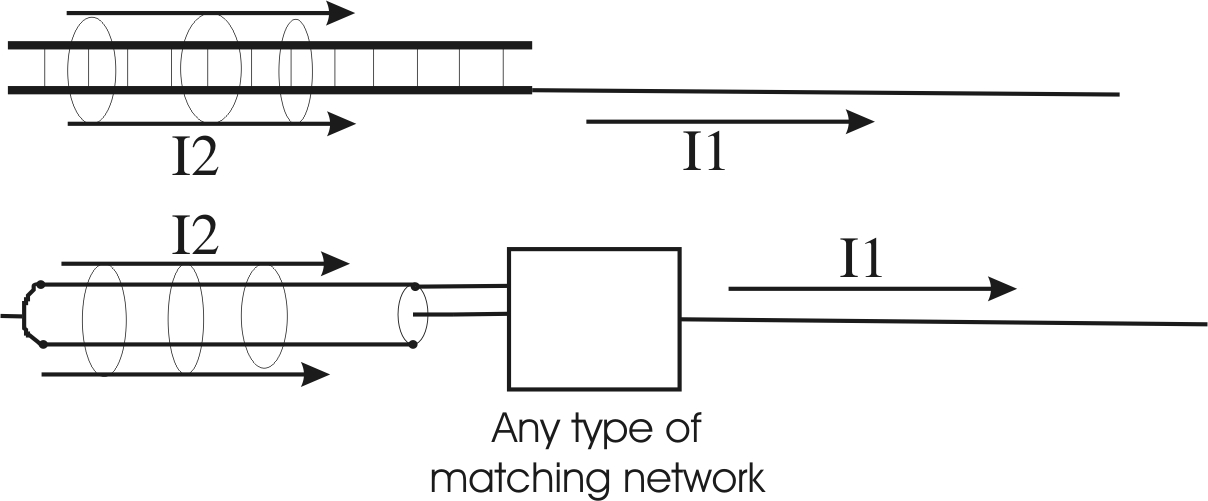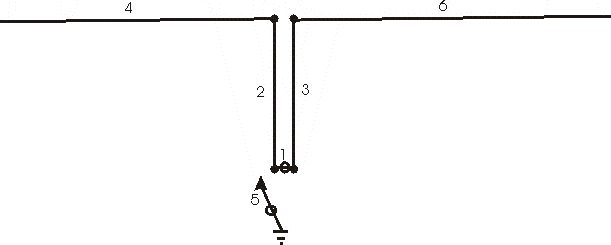End-fed vertical j-pole and horizontal zepp
|
|
|
Related Pages:
End fed longwire or
It is important to understand the feed line before discussing end-fed feed line BalanceWe often hear a balanced feeder Equal currents As a matter of fact, while we virtually never hear this mentioned, voltages must also be balanced in an The complete rules Many articles reach conclusions about feeder balance based on antenna Can we
|
|
|
This drawing
does NOT include
differential or
normal transmission
line currents on the
feed line. It only
shows the
common-mode (I1 and
I2), or “radiating currents”, in the system. Right at
the feedpoint antenna current I1, and
common mode transmission line current I2,
must always be
equal in value and
direction at any
instant of time. The addition of isolation transformers, baluns, or chokes, will not change
this. Only an intentional counterpoise at the feedpoint, in conjunction with
adequate isolation between the feeder and counterpoise/antenna junction, can
significantly reduce I2 common mode. Elsewhere in the system, away from the point where the single conductor
antenna is fed, common-mode (radiating) currents change to other values. Common
mode current levels virtually always increase and decrease, in a pattern of peaks and minimums,
along conductors. A small current or voltage that seems negligible can become a
substantial current or voltage elsewhere in the system.
What misterminates the matching stub or feeder on an end-fed antenna?
One
of the most common
arguments we hear is
the end of a half-wave antenna has
infinite or near
infinite impedance, so it does not require a counterpoise or “ground”.
The end-impedance of a half wave antenna, even at exact resonance, is never
infinite. The end-impedance goes through a relatively broad maximum when an
antenna is approximately resonant as a half-wave, but the dissipative and/or
radiating part of that impedance is limited to a few thousand ohms maximum, even
for very thin conductors primarily having low-loss air insulation. The presence
of lossy dielectrics, or use of a thicker conductor, reduces impedance further.
Because impedance is not infinite, finite
voltages and
currents are
required to
apply power to,
or extract
energy from, the
antenna. The
antenna end-impedance
is always some
finite value between
a few hundred ohms
(for very thick
antennas, like large
diameter tubing or tower sections) to perhaps several thousand
ohms for very thin wire
antennas that are up
high and in the
clear. Because the
antenna end-impedance is
some
finite value, sometimes even lower than we might expect, significant current must be forced
into the antenna end. The feed line or stub connection cannot
force current up or out into
an end-fed antenna without
equal current
flowing into
some form of counterpoise at the
feed line or stub connection.
Also, without equal load impedances on each conductor, like a symmetrical
dipole would have, it becomes impossible to
have perfect feeder terminal voltage and current balance. The end-fed antenna is
grossly non-symmetrical, or
unbalanced. To have a non-radiating feed line, the balanced feed line must have exactly equal and
opposite currents and voltages at the feedpoint and all along the line. This
means feed line
currents
in both conductors must flow into some type of similar termination at
the antenna feedpoint, otherwise the feed line will radiate. The worse
termination imbalance becomes on each feed line or matching stub terminal, the greater
unwanted feeder radiation becomes.
Why does a problem
exist with end-fed antennas?
Kirchhoff’s
Law has
been around a long
time. It is a perfect unbendable rule, just like Ohm’s law. It says, in a roundabout way,
current leaving one point must be matched by current entering the same point from some other
path or paths. In other words, at any junction, we cannot force current out
into something without the same net current coming from something else.
This means we cannot
force power into a
single terminal load. There
has to be a
return path of some type, even if it is not obvious. The path
in a high frequency AC system (like an antenna) does not need to be a direct connection.
The
path can be
through displacement
currents (currents through electric fields),
but there MUST always
be a return path to the source. In the Zepp antenna system, or any end fed
half wave, this displacement current must get back to the feed line somehow. If it
didn’t, it would
have no current
at the ends.
In a normal
“push-pull”
center fed
fed dipole,
displacement
currents largely
(but not
totally) flow
from one side to
the other. This
establishes the
electric field,
and allows
current to flow
outwards into
the wires
hanging
“open”
in space. With
an end-fed,
current flowing
from the stub or feeder out into the end of
the radiator
must be returned
to the opposing conductor of the feed line. This
returned current
(called
displacement
current) always
equals the
common mode
current flowing
into the antenna
end. Without a suitable counterpoise, common mode or
radiating currents
must flow onto the feed cable or supporting mast. This means, lacking a proper counterpoise and
common mode isolation, an accidental (and generally unwanted) feed line or mast
common-mode current must
exist. In the Zepp or J-pole (both are electrically identical), or with
any form of end-fed halfwave, the mast, balanced feed line, or matching stub has to
carry common mode, and to some extent must radiate. If the antenna did not have
such common mode, it would be impossible to apply power to
the antenna.
Do we always notice common-mode (imbalance) problems?
End-fed antennas always have
common-mode
currents in some sort of counterpoise, which is the feed line or mast when lacking a
suitable counterpoise and isolation
at the antenna feedpoint. This does not mean
these undesirable currents are always obvious through some sort of terrible
problem, or that the antenna will not make contacts, or “make the antenna’s
owner happy”. It means the antenna might not be repeatable or reliable, or
have the pattern or performance expected, as a better planned system would have.
The benefit is mechanical simplicity and ease of construction,
while the cost is repeatable electrical performance.
If
impedance was
extremely high, we
could not
efficiently transfer
energy into the
antenna. It would be impossible to design a matching system, especially one with
any bandwidth. The end
impedance of a resonant half-wave antenna actually ranges
from a few hundred
to several thousand
ohms, depending on
conductor diameter and what, even at a distance, is near that conductor.
Let’s look at a
few typical matching
systems…..
The Open Stub
This is the foundation of the J-pole and Zepp antennas. Most of us know a
1/4 wave stub or
Q-section can
transform
impedances. The
formula is
![]() where Zin is the
where Zin is the
input impedance seen
on the rig side, Rload
is the load or
antenna impedance, and Zo is the
Q-section’s (Q is quarter wave)
transmission line
impedance.
For example, a 400-ohm line with a 3200 ohm load is 400 squared (160,000)
over 3200. 160,000 / 3,200 = 50
A 400 ohm Q section will match 50 ohms to 3200 ohms.
There is a fast way to do this, since the ratios relate to SWR on the
matching section. A 3200 ohm load is a 3200/400 = 8:1 SWR. This means the input
has to be an 8:1 SWR on the matching section, which is 400/8=50.
Impedance
transformation
actually relates to
SWR on the Q-section.
We can use this to understand the end-impedance of the halfwave and
counterpoise. Let’s assume we
have an end-fed 1/2
λ and match it
perfectly with 1/4
λ of 450-ohm line.
We know the SWR has
to be 450/50 = 9:1.
From the above
exercise we can
calculate the TOTAL
end impedance seen
by the Q-section at
the antenna, and
that impedance will
tell us the SUM of
counterpoise and
antenna
impedances.
Since the SWR along
the Q-section or stub is
9:1, the sum of
antenna and
counterpoise
impedances is 450 *
9 (SWR) = 4050 ohms!
(4050/450=9:1 SWR)
The fact we can
end-feed a half-wave
through a 1/4 λ
Q-section of 400-450 ohm line, and obtain a reasonable 50-ohm match, proves
antenna
end-impedance is
some value less than
4000 ohms. The maximum
end-impedance of a
typical end-fed thin
wire antenna is a few
thousand ohms at
resonance, and the open terminal of the stub has to act like it is connected to
a counterpoise.
Where is
the counterpoise when we do not intentionally have one? The counterpoise
is matching stub, and this produces common-mode
currents on the Q
section. That Q-section ideally has a common-mode (counterpoise) impedance of a
few hundred ohms at the antenna end, when the stub is ideal. The
antenna and the
Q-section each total a
few thousand ohms
(they are electrically in series), the antenna
and Q-section (stub) share in
some proportion the task of radiating and receiving
signals. How much each contributes depends on the balance and grounding at the
tuner or radio end, the length and other attributes of the stub, and the antenna
element characteristics.
Origination of
J-pole and Zepp
Antennas
This form of
antenna originated
as a practical
solution to feeding
a wire antenna
trailing behind a
dirigible. This type
of antenna, even though the “radiating portion” is 1/2 wavelength and by
itself would be self-resonant (making it a Hertz antenna), it has an additional
1/4 wave added. This makes it at least partially a form of Marconi
antenna. A Marconi antenna always requires a counterpoise of some form.
A Hertz antenna is self-resonant, operating independently of grounds or
counterpoises.
From an early textbook:
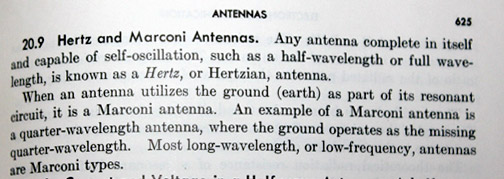
In the Zepp or J-pole antenna is actually 3/4 wave long, with the
counterpoise folded back alongside the radiating element. Make no mistake about
it, no matter how we feed the antenna or how painstakingly we tune the antenna
or stub, the “stub” or feed line will always radiate.
Radiation is minimized when the feeder is 1/4λ long, and the antenna
element 1/2λ long.
To model the real antenna, we must add additional conductors representing the
feed line. The model below, which could be a Zepp or J-pole, includes the feed line:
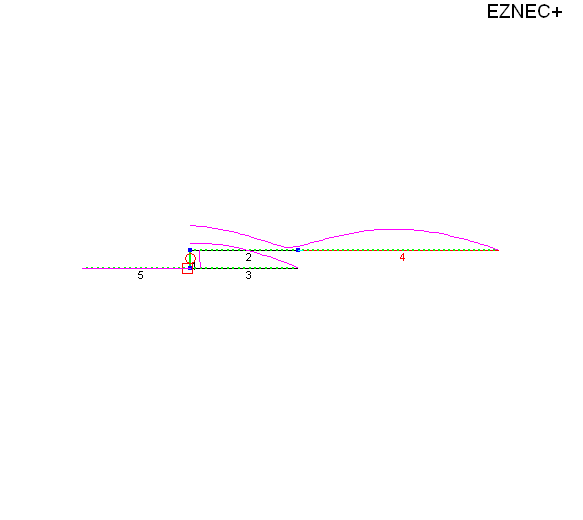
Wire 1 allows a source to be inserted.
Wire 2 is half of a 1/4 λ long feed stub
Wire 3 is the other 1/4 λ long feed stub conductor
Wire 4 is a 1/2 λ element
Wire 5 represents the feed line, in this case it is coax 1/4 λ long and
open at the radio end
The circle is the source
The square is a balun. In this case, the balun has an impedance of 1000 +j3000
ohms.
This model would also represent an end-fed Zepp with a grounded tuner and a
good balun.
Ground currents flowing from the balun to the case of the tuner are 1.5% of peak antenna
current, which (especially at low power) is not too bad.
When the model includes an imperfect balun or less-than-ideal feed line
length, we see things change dramatically.
Here is what happens when a
worse-case ground path is added to the Zepp or J-pole model:
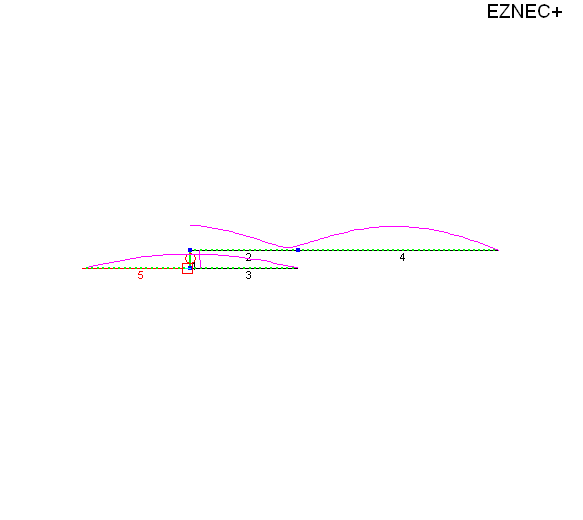
In this case we find severe common mode currents on wire 5, the feed line.
feed line currents causing unwanted feed line radiation are 57% of peak
antenna current!!!
This system would represent a direct feed with coax, or a tuner
on a normal Zepp, with no balun.
Typically, the antenna Hams call Zepps are bent like this:
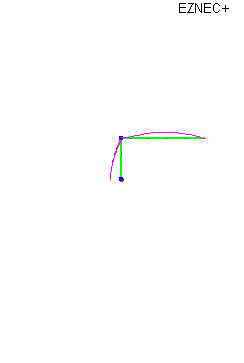
Bending the antenna will not correct the feeder problems mentioned above!!
Everything remains the same. The Zepp (angle between the stub and antenna
element) and the J-pole (all in line) are physically different, but electrically
identical, systems.
Zepp Feeder and Element Length
Ideal element length is 1/2λ, or a low multiple of 1/2λ, such
as a full wavelength. This is to ensure the feeder has the highest possible
terminating impedance at the antenna, making balance between the open and
element connection terminals the best possible.
The ideal feeder length for a Zepp antenna is 1/4λ. The second best
choice would be 3/4λ long. Maximum feeder radiation, as well as maximum
feeder unbalance, occurs when the feeder is 1/2λ long. The chart
below shows currents in the feeder or stub of a properly constructed 80-meter
Zepp. Pay particular attention to the unbalanced current levels (red column),
and where the peak unbalance occurs:
| 3.6 MHz | 1000 watts | Current | |
| Feet from tuner |
Stub 1 | Stub 2 | unbalance in amperes |
| 2.5 | 7.07 | 7.07 | 0.00 |
| 5 | 7.04 | 7.01 | 0.03 |
| 7.5 | 6.97 | 6.91 | 0.06 |
| 10 | 6.88 | 6.79 | 0.09 |
| 12.5 | 6.76 | 6.65 | 0.11 |
| 15 | 6.62 | 6.49 | 0.13 |
| 17.5 | 6.46 | 6.30 | 0.15 |
| 20 | 6.26 | 6.09 | 0.17 |
| 22.5 | 6.05 | 5.87 | 0.18 |
| 25 | 5.81 | 5.62 | 0.20 |
| 27.5 | 5.55 | 5.35 | 0.21 |
| 30 | 5.28 | 5.06 | 0.21 |
| 32.5 | 4.98 | 4.76 | 0.22 |
| 35 | 4.66 | 4.44 | 0.22 |
| 37.5 | 4.32 | 4.11 | 0.22 |
| 40 | 3.97 | 3.76 | 0.21 |
| 42.5 | 3.61 | 3.40 | 0.20 |
| 45 | 3.22 | 3.03 | 0.19 |
| 47.5 | 2.83 | 2.66 | 0.17 |
| 50 | 2.42 | 2.28 | 0.15 |
| 52.5 | 2.01 | 1.89 | 0.12 |
| 55 | 1.58 | 1.51 | 0.08 |
| 57.5 | 1.15 | 1.13 | 0.01 |
| 60 | 0.70 | 0.79 | 0.09 |
| at antenna |
0.25 open | 0.54 wire | 0.30 |
Table above shows 1/4 wavelength
stub feeding 1/2 wavelength antenna. Perfect current balun assumed.
On 80 meters, with an 80-meter Zepp (1/4λ
feeder stub, 1/2λ element), the system needs equal currents in each
conductor at the balun or tuner. We should use a current balun.
On 40 meters, the same antenna would have a 1/2λ feeder with a 1λ
element. In this case the best feed line balance, and lowest feeder radiation,
occurs with a split voltage source. The best balun is a voltage balun.
Unfortunately, even the best voltage balun will not suppress fields surrounding
the feeder on 40 meters, when the Zepp has a 1/2λ feeder.
| 7.1 MHz | 1000 watts | Current | |
| Feet from tuner | Stub 1 | Stub 2 | unbalance in amperes |
| 1.63 tuner |
1.63 tuner | 0.00 | |
| 5 | 2.40 | 2.03 | 0.36 |
| 3.23 | 2.49 | 0.73 | |
| 10 | 4.00 | 2.93 | 1.07 |
| 4.71 | 3.34 | 1.37 | |
| 15 | 5.35 | 3.70 | 1.65 |
| 5.92 | 4.01 | 1.90 | |
| 20 | 6.40 | 4.28 | 2.12 |
| 6.79 | 4.48 | 2.31 | |
| 25 | 7.08 | 4.62 | 2.46 |
| 7.28 | 4.70 | 2.57 | |
| 30 | 7.37 | 4.72 | 2.65 |
| 7.36 | 4.67 | 2.69 | |
| 35 | 7.25 | 4.56 | 2.69 |
| 7.03 | 4.38 | 2.65 | |
| 40 | 6.72 | 4.15 | 2.57 |
| 6.31 | 3.85 | 2.46 | |
| 45 | 5.81 | 3.51 | 2.30 |
| 5.24 | 3.12 | 2.11 | |
| 50 | 4.58 | 2.69 | 1.89 |
| 3.86 | 2.23 | 1.63 | |
| 55 | 3.09 | 1.76 | 1.33 |
| 2.26 | 1.28 | 0.98 | |
| 60 | 1.40 | 0.84 | 0.56 |
| at antenna | 0.49 open |
0.57 wire | -0.08 |
| The table above shows current imbalance in a 1/2 wavelength stub system, when the Zepp is used on the second harmonic. Perfect current balun assumed. |
The sever unbalance above does not mean the Zepp will not “work” or will not make contacts,
but it does mean chances of RF-in-the-shack and feeder radiation
is significantly worse on even harmonics of the design band. We can expect the best performance, or the
most repeatable performance, on odd-harmonics of the design band.
If
any antenna using a two-wire feeder is fed
properly, there is
absolutely no need
for a station RF
ground. The station
RF ground is usually a Band-Aid for an error of some type, often rooted in compromised antenna system
design. If
an antenna is
modeled properly to
include feed lines
and tuners, the model will
show real-world problems that
perfect-source models
overlook.
Conclusions about
system behavior
often change considerably when tuners
and transmission
lines are included
in models.
Eliminating the Stub, and using a Tuned
Circuit
A second matching
method eliminates the stub by using a resonant circuit with a link, or a
modification of the link circuit. These antennas are called end-fed halfwaves, or EFHW
antennas. Such antennas are really just a modification of the old original Zepp or J-pole
antennas. Even though modernized with a feedpoint matching system, they still have all of the Zepp or J-pole
feeder common-mode problems.
The Double Zepp
This is a poor
name. The double
Zepp is really just
a doublet, or dipole, fed with a balanced
line. The line is generally high
impedance ladder line, or in some cases, open wire line. Including the feeder
and looking
at feeder currents demonstrated problems associated with
regular amateur
radio Zepp antennas,
so let’s look
at the “Double
Zepp”.
Here is the Eznec wire
table of the double
Zepp:
Double Zepp 4/29/2007 3:51:32 PM
--------------- WIRES ---------------
No. End 1 Coord. (ft) End 2 Coord. (ft) Dia (in) Segs Insulation
Conn. X Y Z Conn. X Y Z Diel C Thk(in)
1 W2E1 0, 0.3, 1 W3E1 0, 0, 1 #14 1 1 0
2 W5E2 0, 0.3, 1 W6E1 0, 0.3, 65 #14 65 1 0
3 W1E2 0, 0, 1 W4E1 0, 0, 65 #14 65 1 0
4 W3E2 0, 0, 65 130, 0, 65 #14 130 1 0
5 GND 0, 0.15, 0 W1E1 0, 0.3, 1 #14 5 1 0
6 W2E2 0, 0.3, 65 -130, 0, 65 #14 130 1 0
Wire 1 allows insertion of the source. It is a jumper across the feed line.
Wires 2 and 3 are the balanced feed line.
Wires 4 and 6 are 130-foot, forming a 260 foot long "dipole".
Wire 5 allows us to test balance
The sources:
There are two sources in the above model.
- Source 1 is in the middle of wire 1, at the normal feedpoint
- Source 2 is in the middle of wire 5. In this case wire 5 is connected to
the junction of wire 2 and 1
The second source, in wire 5, is set for zero amperes.
This means the
voltage and phase
would be the voltage
and phase
required to produce
zero amperes to ground. For the right terminal near the stub bottom, at source
1:
Frequency = 3.75 MHz
wire 5 Source 2 Voltage = 171.3 V. at -147.94 deg.
Current = 0 A. at 0.0 deg.
Total applied power = 1500 watts
Now watch source 2 as we move wire 5 to the left feeder terminal:
Frequency = 3.75 MHz
wire 5 Source 2 Voltage = 171.1 V. at 31.79 deg.
Total applied power = 1500 watts
Notice the nearly
perfect voltage balance. The
voltage difference
is only 0.2 volts
out of 171 volts. The phase difference is 179.73 degrees, almost perfectly 180
degrees! This is a well-balanced feeder. It
will not radiate
significantly, and
the voltage from each
terminal of a tuner
to ground would be nearly
equal, along with
perfectly balanced
currents in each
leg.
The 171 volts
is very manageable
from a tuner, and it
won’t matter much if
the tuner uses a good voltage
balun, or a good
current balun. This
is a simple system
that would be
unlikely to produce
much RF in the
shack.
If we do
nearfield electric
field table around
the feed line, we
find the electric
field out several
feet from the
transmission line in
the house is fairly
low. This is with a
“perfect” tuner.
The Zepp in comparison to the double Zepp
Now
let’s delete one of
the wires so we have
a traditional
amateur Zepp and, in the same test, see
what happens with feeder voltages. The
antenna model looks
like this:
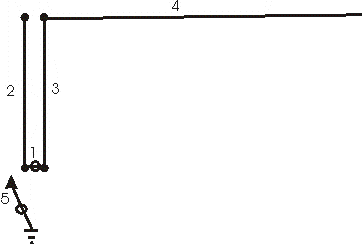
The wire table
is:
EZNEC+ ver. 4.0
Zepp 4/29/2007 11:10:47 PM
--------------- WIRES ---------------
No. End 1 Coord. (ft) End 2 Coord. (ft) Dia (in) Segs Insulation
Conn. X Y Z Conn. X Y Z Diel C Thk(in)
1 W2E1 0, 0.3, 1 W3E1 0, 0, 1 #14 1 1 0
2 W5E2 0, 0.3, 1 0, 0.3, 65 #14 65 1 0
3 W1E2 0, 0, 1 W4E1 0, 0, 65 #14 65 1 0
4 W3E2 0, 0, 65 130, 0, 65 #14 130 1 0
5 GND 0, 0.15, 0 W1E1 0, 0.3, 1 #14 3 1 0
Terminal voltages and currents at the stub bottom, on the right terminal of source 1, are:
Frequency = 3.75 MHz
Right term Current = 8.537 A. at 0.0 deg.
Right term Voltage = 131.5 V. at -8.8 deg.
Total applied power = 1500 watts
and on the left
terminal:
Frequency = 3.75 MHz
Left term Current = 7.51 A. at 0.0 deg.
Left term Voltage = 285.6 V. at -5.45 deg.
Total applied power = 1500 watts
We see now the
phase and amplitude
of voltages at each
source terminal are
not equal.
Voltage difference
is 154.1 volts, making one feeder terminal have only 46% of the opposing
terminal’s voltage.
Phase difference
is only 3.35
degrees, and current in one feed terminal is 88% of the other terminal.
Despite the fact
current appears
reasonably even in both feeder
wires near the
source, the large
unbalance in voltage
represents significant localized electric field
problems around the feeder. A regular
voltage balun, or balanced-voltage tuner like a Johnson Kilowatt Matchbox, while
it would work fine with the double-Zepp, would
not work well with the true Zepp, so far as RFI and RF-in-the-shack is concerned.
Even a good current
balun would be
taxed by voltage imbalance issues, and we would have to contend with one ampere
of RF current flowing out into the cases of station equipment. This is why
people have problems
with RF-in-the-shack
from Zepps, despite
what models lacking
a feed line or using
infinite source
isolation might tell
us. (By the way
if you are
uncomfortable using
a zero ampere source
to measure voltage,
you could substitute
a very high
impedance load in
wire 5 to model balun stress.)
Another way to
determine unbalance,
and remember VOLTAGE
or phase unbalance
is just as harmful as current unbalance
to devices near or
connected to the
feed line, is to run
a Near Field table
of the electric
field. If we do that
we will find the end
fed Zepp has from a
few times to a dozen
times or more the
electric field
levels near the
feed line as a center
fed double Zepp with
about the same
feed line impedance
and the same power
level!
In the
EZned tabular data for near-field energy, I
examined the end-fed
Zepp in comparison to a double Zepp. The traditional Zepp had many places where the electric
field, 5 feet from
the feed line, was ten
times or more higher
than a center fed
balanced double Zepp antenna. The claim by some
sources that an end-fed Zepp has minimal
radiation and good
feed line balance is
clearly false. The
authors made the
fatal mistake of not
modeling the near
field levels for the
same power level and
same feed line
impedance (conductor
to conductor
voltage).
They also
did not check
voltage balance,
which is just as
important for
preventing near
field problems like
RF in the shack. They only looked at
one parameter, pattern and current, and
concluded if current
was balanced or pattern reasonable, the
feed line was tame. The problem isn’t
always far-field pattern,
the problem is
feed line balance and
RFI in the near
field.
The ideal 1/2
wave Zepp antenna
shows no pattern
distortion:
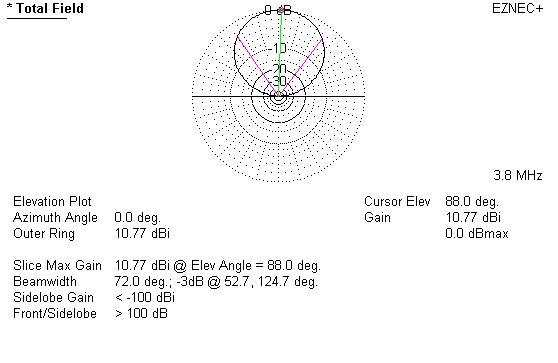
Although high
feed line currents
appear, they are
closely balanced and
out-of-phase. This
is why many authors conclude
feed line radiation
is not a problem,
and I agree for
this specific
perfect case! The
specific case is the
tuner on your desk
must have infinite
common mode
impedance, it must
be a perfect ground
independent source.
The real world
adds a few
variables, however.
Real-world sources
are not perfectly ground-independent like sources in modeling programs, real-world antennas
are not always 1/2
λ long nearly lossless radiators, and
real-world feed lines
are not always 1/4
λ long (in common-mode length) on every
band. Often the real world is much worse than a model, and rarely is it as good
as a model.
Let’s explore
what happens when
the real world
meets the perfect
model!
Adding a
worse-case ground
path to a perfect
antenna, we have:
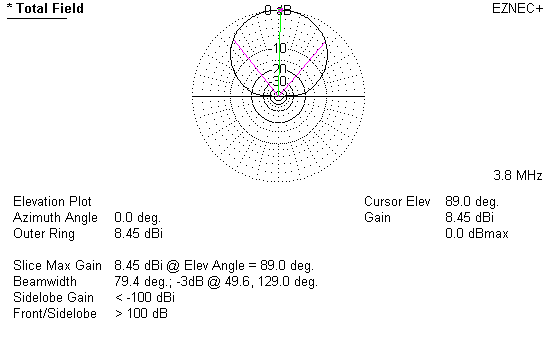
Now we see a
slight flattening of
the bottom of the
pattern. While the
pattern does not
change much, which some authors might wrongly conclude means no RFI or feeder
balance problems, we have
the following
currents at 500
watts:
- 6.1 amperes
feed line wire 1 - 5.35 amperes
feed line wire 2 - .75 amperes
ground
path
Even with the
small pattern error,
we now have a very
significant .75
amperes flowing to
earth through
station equipment,
and perhaps
eventually the
operator (RF burns). This is
with an ideal length Zepp or EFHW
antenna, and a
typical wrong length antenna feed. Pattern alone does not prove proper feeder
operation, and balanced currents at one point do not prove freedom from feeder radiation.
To minimize radiation from the Zepp, and to minimize RF in the shack, the
feeder or stub should be an odd multiple of 1/4 wavelength long. The element
should be a halfwave, or a multiple of 1/2 wavelength, long. The tuner or
coaxial feed line should have a good common-mode isolating device, like a current
balun, at the interface to the stub.
Most of all remember, pattern does not prove balance.
The J-Pole
This page has
hits
since creation on
July 31, 2004
